Water, Water Everywhere
Flooding is an increasing problem throughout Bergen, and it’s likely to get worse. Do we have the will—and the funds—to fix it?

The video is a document of desperation. A mere 10 seconds long, it shows a torrent of water pouring down Marlene Resciniti’s backyard steps into her finished basement—a sight, to Resciniti, that’s both horrific and familiar. She’s lived in her Woodland Park house for 36 years, and in the past two decades she’s experienced four major floods and countless near misses. When she first saw the house in 1988, the Dowling Brook meandering past the backyard was part of the property’s allure; today it’s a source of fear and frustration.
“I’m living a nightmare here,” Resciniti says. When she bought the house, she wasn’t required to carry flood insurance because the risk of flooding was so low—just one percent over the course of 100 years. That’s no longer the case. “As the years went on,” she says, “there was more building going on; now the water has nowhere to go with the runoff, and I’m in a flood zone.”
It’s a refrain you’re likely to hear from residents throughout Bergen County, many of whom never imagined they’d be living in a flood zone or battling floodwaters on a regular basis. And even those who knew when they bought their homes that flooding was a possibility didn’t expect it to become a probability. It’s a state of affairs, flood victims attest, that can erode one’s sense of well-being. “My wife takes it particularly hard,” says Brian Paladino, a Lodi resident whose house has flooded eight times over the past 20 years. “Every time we get heavy rain, she’s watching out the window.”
It can also erode one’s bank account. Albert Di Chiara, who owns the Di Chiara Funeral Home in Lodi and lives above the business, has lost hundreds of thousands of dollars in a series of floods and spent more than $100,000 in flood mitigation efforts. And that expense doesn’t include flood insurance, which costs him $25,000 a year. Even so, insurance typically doesn’t cover the entirety of a loss. During Hurricane Floyd, in 1999, Di Chiara had 13 feet of water in his basement and 2 feet on the first floor, and his losses from the flood approached $600,000, for which FEMA—the Federal Emergency Management Agency, which provides flood insurance to homeowners and businesses—reimbursed him $212,000. The difference, he says, “came away from my mother’s retirement, my uncle’s retirement, our savings.”
Flooding—dreading it, fighting it, paying for it—has become an intrinsic part of life for an increasing number of Bergen households and it’s likely to become more common, and affect a growing number of residents, as time goes on. The problem, of course, isn’t just local. A 2022 study out of the University of Oklahoma, for example, predicted “widespread increases” in the occurrence of flash flooding across the U.S. While efforts are underway to address the problem, virtually everyone—from government officials to water resources engineers to frustrated residents— agrees that they’re insufficient. To truly mitigate Bergen’s flooding will require large measures of determination, engineering ingenuity, forward thinking and, of course, money.
OUR WORSENING WATER WOES
Bergen County isn’t alone in its propensity to flood. “The Northeast in general is experiencing more rainfall, including more frequent storms that are shorter in duration but higher in intensity,” says Hannah Talos, a water resources engineer with LAN Associates in Midland Park. The culprit, says Rutgers water resources engineer Qizhong (George) Guo, is a warming climate, since warm air holds more moisture than cold air. Those surge storms are particularly dangerous because they don’t allow sufficient time for rainwater to be absorbed by soil, drainage systems and bodies of open water.
If climate has delivered one blow, overdevelopment has turned it into a one-two punch. In densely populated Bergen, says Talos, “we have so much impervious surface—roads, parking lots and other paved areas— that don’t let water in but just force it to run off.” If those first two punches don’t knock us out, there’s a third that might. “Our drainage infrastructure hasn’t been sufficiently maintained and is deteriorating,” says Guo. And even if it were in pristine condition, that infrastructure wasn’t built to handle the amount and type of rainfall that we’re experiencing today.
Though waterways aren’t, strictly speaking, infrastructure, they too are suffering from a lack of maintenance, in the sense that silt, over the years, has been allowed to build up in them, rendering many streams and rivers significantly shallower—and therefore less capable of holding waters from heavy rainfall—than they were years ago. Scott Luna, mayor of Lodi and a lifelong resident of the borough, notes that “years ago, Lodi had beaches along the Saddle River—you could swim in it. Today, some spots in the river are so low you could walk across them.”
LOCAL SOLUTIONS: A DROP IN THE BUCKET?
In recent years, officials have acknowledged the severity of our flooding problem and ramped up efforts to address it. In many localities, those efforts start with making sure that areas designed for drainage, including pipes and culverts, are cleared of silt and debris. Tracy Kallert, mayor of Woodland Park, notes that the borough’s Department of Public Works has made clearing drainage areas a priority. “Our DPW makes it a point to clean out the catch basins and culverts a week before floods and heavy rainfall are predicted, to make sure that the rivers and the brook are flowing freely,” he says. “That has really limited flooding.” Guo considers this kind of maintenance critical to flood control efforts, but says it’s labor-intensive and therefore expensive.
This March, the federal government addressed some of the county’s oldest and most dysfunctional drainage systems with $4.7 million in grants to Emerson, Englewood, Leonia and Tenafly. The money will go toward projects that include the creation of water retention basins, new drainage pipes and other drainage infrastructure, as well as drainage maintenance.
One long-term effort, in Bergen County and throughout New Jersey, is the state’s Blue Acres program, which has been buying up properties built in floodplains—areas naturally prone to flooding—and converting them to water storage, parks and open spaces. The program has acquired 19 properties in New Milford along the Hackensack River. While it has certainly had an effect in New Milford, as well as other communities downriver, there are still far too many properties standing in Bergen’s floodplains.
BIG PROJECTS: HOPE FOR THE FUTURE
A number of Bergen communities have been in conversations with the U.S. Army Corps of Engineers about major engineering solutions to the problem of flooding, with funding coming from the federal government. For more than a decade, for instance, the Corps has been conducting studies on flood remediation in Woodland Park and Little Falls. Plans could include the construction of a $150 million flood tunnel. Kallert believes that the project will come to fruition, but not overnight. “Originally,” she says, “I’d thought it might happen in 2024, 2025. Now it’s looking like 2026, 2027. While it’s frustrating, it’s good to know that there’s hope around the corner.”
Luna is a little less hopeful for Lodi. A study by the Army Corps of Engineers to ameliorate flooding in towns along the Saddle River was scrubbed in 1997 because the river had changed significantly while the study was being done, and the Corps is now working on a second study. The solution, Luna says, could be a flood tunnel, dredging of the river or the construction of a flood wall. “It might not happen in my lifetime,” he adds. “But without federal relief, we can’t do it.”
Money isn’t the only factor holding back municipalities from making major flood-mitigation changes. Paul Vagianos, mayor of Ridgewood, says that, to prevent overflow from a stream running behind Ridgewood High School, the town could build a berm. But in fact, the town is forbidden by law to do so because it would adversely affect other communities along the stream.
NEEDED: A NEW PHILOSOPHY
Given enough money and time, major engineering projects may well solve some of Bergen’s flooding problems. But to address a future in which flooding is increasingly common, we’re going to need a sea change in our attitudes about growth and development. That doesn’t just mean no future construction on floodplains.
“Having more green space, more trees and plants that take up water, and more pervious ground is, I think, the most effective way to slow down the speed of water,” says Talos, and slowing water is the key to keeping a rainfall event from turning into a flood event. Instead of, say, building a parking lot that’s a stretch of asphalt, equipped with inlets to collect stormwater and pipe it out to a large catch basin, we could build grass islands throughout the lot to absorb water.
We could, says Guo, construct green roofs— planted with vegetation over a growing medium and a waterproof membrane, like the roof atop the Meadowlands Environment Center in Lyndhurst. We could also build bioswales— channels, usually mulched or planted, to concentrate and filter stormwater runoff. We might even create so-called floodable parks, that transform temporarily into ponds during surge storms. Essentially, we need to start enlisting nature in our efforts to reduce flooding, rather than fighting against nature.
“I believe that green solutions are going to be more and more important,” says Talos, “in a future characterized by increasing amounts of flooding.”

